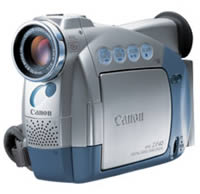Canon ZR40 Digital Camcorder
Canon Updated: 2007-08-02The right size. The right price. The Canon ZR40 is the right choice for preserving special moments with family and friends. Shooting extraordinary video is effortless. The ZR40 provides you with all the features you need to make you shoot like a pro.
All the benefits of digital video, Digital Photo Mode, a 2.5" Flexible Color View Screen, 18X Optical Zoom/360X Digital Zoom, Color Night Mode, Image Stabilization, High Quality Microphone, Built-in Analog to Digital Converter, and more!
Features
- Digital Video Format and IEEE 1394
- Image Stabilizer
- Precision Canon Optical Zoom Lens
- Shooting Modes
- Color Viewfinder and 2.5" LCD Screen
- Programmed Auto Exposure
- Manual Controls
- Digital Effects, Faders and Special Effects
- PCM Digital Stereo Sound
- IEEE 1394 Input and Output Terminal
- Video and Audio Inputs and Outputs
- Additional Features
Digital Video Format and IEEE 1394
The Canon ZR40 is a digital video camcorder using the standard MiniDV cassette, designed to produce the highest quality video possible from non-broadcast equipment. The MiniDV format standard delivers more than 500 lines of horizontal resolution. In terms of picture quality, this is about 25% better than the best analog formats. On top of that, because the MiniDV format records both video and audio as digital data, this information can be transferred -- without any loss of picture or audio quality -- to a computer for editing, then transferred back to DV tape, without a reduction in either picture or audio quality. This transfer of data is accomplished using the IEEE 1394 protocol commonly known as FireWire®.
DV Format Technology and Advantages
The DV format is based on a robust videotape formulation, a sophisticated and computer-based data capture system, the ability to transfer data from camcorder to tape at high speed, and a standard data structuring system. The MiniDV format makes professional quality video affordable.
Better picture quality, sharper images and better color reproduction than analog -- that's the digital video story. Digital recordings are almost immune to signal problems, and deliver the highest quality picture and audio. This is a major advantage over analog recordings. Digital is the language of computers, which easily store and transfer data without distortion. The same holds true for digital video. Digital copies of digital videos are indistinguishable from the original, which makes editing and image manipulation so much easier and with higher quality than that delivered by analog video technology.
The video tape formulation used for digital video is designed to last longer and even withstand repeated use without failure, which virtually eliminates dropouts while delivering higher output and less noise.
Digital video has approximately twice the horizontal resolution of a standard VHS videocassette recorder. The resolution of a DV standard image is about 25% better than that from an S-VHS or Hi-8 camcorder or VCR. While resolution is dependent on a product's components and circuitry, standard VHS and 8mm video are capable of delivering about 250 lines of horizontal resolution with S-VHS and Hi-8 at about 400-420 lines. The DV format is capable of delivering more than 500 lines of horizontal resolution, with actual performance depending on the individual camcorder model. Another way to look at it is that an NTSC digital video signal contains more than twice the data of its analog counterpart; a PAL digital video signal contains over three times the data of its analog counterpart.
Color resolution (or rendition) can be a problem for analog video, producing color blur and color noise. Digital video does not have this problem, delivering a far more life-like video image on the screen. What you will see is much sharper subject edges and clearer color reproduction.
The MiniDV standard ensures that audio quality matches that of an audio CD or digital audio tape (DAT). The audio portion of the digital video signal also is recorded digitally. The digital video standard includes Pulse Code Modulation (PCM) audio recording, delivering more than the normal, natural range of sound audible to humans without both distortion and noise.
All digital video equipment also has the analog video outputs (either S-video and/or composite video) found on current analog equipment. This means you can play a digital video on a regular TV, or transfer a digital video onto an analog VCR. If you record using a digital video camcorder, you can then copy the video onto VHS or Super-VHS tapes, 8mm or Hi-8 tapes, or any of the broadcast formats such as 3/4-inch or Betacam if the recording equipment has the appropriate input connectors.
ZR40/45MC/50MC Brochure
ZR40 Instruction Manual
Related Manuals
Canon ZR10 Digital Camcorder
Canon Elura 60/65/70 Digital Camcorder
Canon ZR20 Digital Camcorder
Canon ZR Digital Camcorder
Canon Vistura Digital Camcorder
Canon ZR25MC Digital Camcorder
Canon Optura 10 Digital Camcorder
Canon ZR30MC Digital Camcorder
Canon Ultura Digital Camcorder
Canon Elura 50 Digital Camcorder
Canon ZR45MC Digital Camcorder
Canon Optura 20 Digital Camcorder
